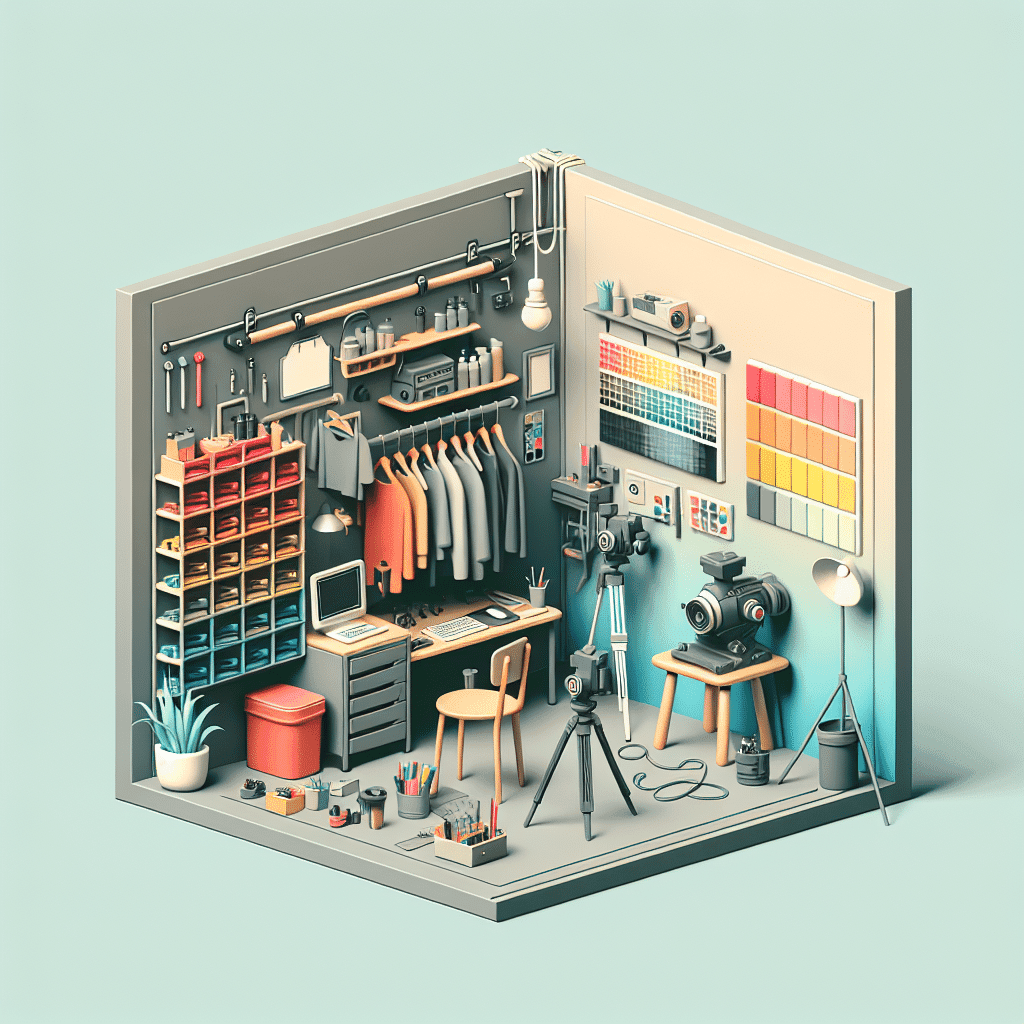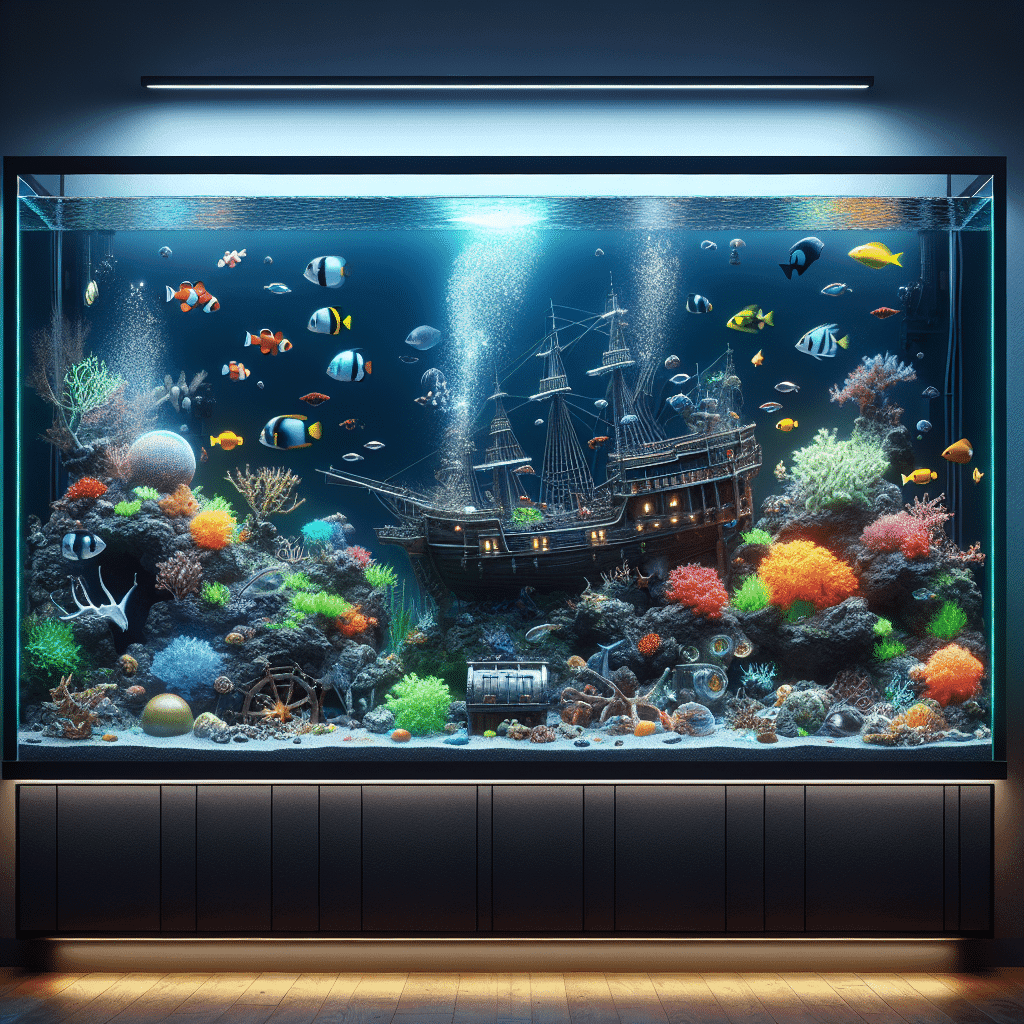Setting Up Your Reef Tank
Setting up my reef tank is an exciting journey that begins with careful planning and thoughtful equipment placement. Having a well-organized setup not only enhances the visual appeal of my aquarium but also ensures a thriving environment for my marine life.
Planning Your Tank Space
Before diving into the actual setup, I take time to plan my tank space effectively. I consider the following factors:
- Tank Size: The size of my aquarium dictates the type and amount of equipment I can use. Larger tanks generally provide more stability but require more equipment.
- Aquascaping: Planning the layout of rocks, corals, and other decorations is essential. I want to create hiding spots for fish and open spaces for swimming.
- Flow and Circulation: I ensure that water flow reaches all areas of the tank, as this is vital for the health of corals and fish. I plan for pump placement accordingly.
I often sketch my ideas and use a table to compare the dimensions of different elements.
| Element | Recommended Size |
|---|---|
| Tank Height | 24-36 inches |
| Tank Width | 36-48 inches |
| Rock Structure Height | 12-24 inches |
| Coral Placement Height | 6-12 inches |
Equipment Placement
Once I have a solid plan for my tank space, I turn my attention to equipment placement. Proper positioning of my equipment is crucial for both functionality and aesthetics. Here are the main components I focus on:
Filtration Systems: I position the filter in an area where it can efficiently circulate water throughout the tank. It should also be easily accessible for maintenance.
Lighting Options: Adequate lighting is critical for coral growth. I mount my lights securely above the tank, ensuring they provide even coverage without creating hotspots. For more information on lighting, I check out light management.
Heaters and Chillers: These should be placed to promote even temperature distribution. I often place them near the filter output to maximize circulation.
Pumps and Powerheads: I strategically place these to create optimal water movement in my reef tank. I ensure they are positioned away from coral to prevent damage.
Skimmers and Reactors: I prefer these to be located near the surface to maximize air-to-water contact and ensure effective operation.
By organizing my tank with thoughtful equipment placement, I can enhance the overall health of my reef ecosystem. For more details on setting up my aquarium, I often refer to guides on saltwater aquarium setup and aquarium maintenance. This planning phase sets the foundation for a beautiful and thriving marine environment.
Essential Equipment for a Reef Tank
Setting up a reef tank is truly an exciting journey! One of the most important aspects of creating a thriving marine ecosystem is selecting the right equipment. In this section, I’ll dive into two essential components: filtration systems and lighting options.
Filtration Systems
Filtration is vital for maintaining a healthy reef tank. It helps keep the water clean and free of harmful substances, ensuring a suitable environment for your fish and corals. There are several types of filtration systems to consider, and each has its unique benefits.
| Filtration Type | Description | Pros |
|---|---|---|
| Mechanical Filtration | Removes debris and particles from the water | Easy to maintain, inexpensive |
| Chemical Filtration | Uses activated carbon or other media to remove toxins | Effective at removing impurities |
| Biological Filtration | Supports beneficial bacteria that break down waste | Promotes a healthy ecosystem |
For the best results, I recommend using a combination of these filtration methods. This way, you can effectively manage various pollutants in your reef tank. Don’t forget to check out our article on aquarium maintenance for tips on keeping your filter in top shape!
Lighting Options
Proper lighting is another crucial element in setting up my reef tank. Corals and other marine life rely on light for photosynthesis, so selecting the right lighting system is essential for their growth and health. There are various lighting options available:
| Lighting Type | Description | Pros |
|---|---|---|
| LED Lighting | Energy-efficient and long-lasting lights | Adjustable spectrum, low heat |
| T5 Fluorescent | Offers good color rendition and brightness | Cost-effective, versatile |
| Metal Halide | Provides intense light for deep tanks | Excellent for coral growth |
LED lights are my personal favorite because they are energy-efficient and have a long lifespan. I can easily adjust their spectrum to match the needs of different corals. For more information on managing light in your reef tank, visit our article on light management.
By carefully considering my filtration system and lighting options, I can create a thriving environment for my marine life. These essential pieces of equipment play a vital role in ensuring the success of my reef tank. Don’t forget to keep an eye on water parameters and perform regular water changes to maintain optimal conditions for my aquatic friends!
Caring for Coral in Your Tank
Caring for coral in my reef tank is one of the most exciting parts of this hobby. Two fascinating types of coral I love to keep are Organ Pipe Coral and Cabbage Coral. Each has its unique needs and characteristics, so let’s dive into how I care for them in my aquarium.
Organ Pipe Coral Care
Organ Pipe Coral is such a beautiful addition to any reef tank. They thrive in moderate lighting and can adapt to a variety of water conditions. Here’s a quick overview of their care requirements:
| Care Aspect | Details |
|---|---|
| Lighting | Moderate to high (around 100-300 PAR) |
| Water Flow | Moderate flow preferred |
| Feeding | Zooplankton and small meaty foods |
| Placement | Place on the substrate or rock structures |
To ensure my Organ Pipe Coral thrives, I focus on providing suitable light management and maintaining water parameters. Feeding them small amounts of zooplankton a few times a week keeps them healthy and encourages growth. For more general tips about maintaining my aquarium, I refer to my aquarium maintenance guide.
Cabbage Coral Care
Cabbage Coral is another favorite of mine! Its unique shape adds visual interest to my tank, and it’s generally easy to care for. Here’s how I manage the care for my Cabbage Coral:
| Care Aspect | Details |
|---|---|
| Lighting | Moderate to high (around 150-250 PAR) |
| Water Flow | Moderate to strong flow preferred |
| Feeding | Phytoplankton and liquid coral foods |
| Placement | Attach to stable rocks or ledges |
Cabbage Coral enjoys a bit more flow than Organ Pipe Coral, so I make sure to adjust my water current accordingly. I regularly feed them with phytoplankton and specialized liquid coral foods to support their growth. Keeping an eye on water changes is essential for maintaining a stable environment.
Both corals require a well-maintained environment with attention to water safety and parameters like salinity and pH. I often check for alkalinity management and ensure my tank is properly cycled by referring to my saltwater aquarium cycling notes.
Caring for Organ Pipe and Cabbage Coral has been a rewarding experience, and I enjoy watching them flourish in my reef tank. They not only enhance the beauty of my aquarium but also contribute to the overall health of the marine ecosystem.
Understanding Coral Reefs
Coral reefs are fascinating ecosystems, and I find their complexity and beauty truly inspiring! Understanding how they function is key to creating a thriving marine aquarium.
Coral Reef Biodiversity
Coral reefs cover only 1% of the world’s oceans but provide essential habitats for at least 25% of marine life. This makes them incredibly important for biodiversity. Did you know that coral reefs are believed to have the highest biodiversity of any ecosystem on Earth, even surpassing tropical rainforests? They host over 4,000 species of fish, corals, and other marine organisms (Coral Reef Alliance).
| Aspect | Detail |
|---|---|
| Total Species | Over 4,000 |
| Coverage of Oceans | 1% |
| Marine Life Supported | 25% |
Understanding the biodiversity of coral reefs is crucial, as a diverse ecosystem is often better equipped to withstand disturbances such as climate change and pollution. Over half of the world’s coral reefs are located in just six countries: Australia, Indonesia, the Philippines, Papua New Guinea, Fiji, and the Maldives (Coral Reef Alliance). This diversity ensures the health and stability of coral reefs, making them a vital part of our oceans.
Coral Reproduction
When it comes to coral reproduction, I find the process quite remarkable! Corals engage in mass spawning events where they release their sperm and eggs into the water. This synchronized dance ensures successful fertilization while minimizing hybridization, as corals are mostly sedentary (Coral Reef Alliance).
This reproductive strategy is not only fascinating but also essential for maintaining coral populations. The timing of these events is often synchronized with lunar cycles, ensuring that conditions are optimal for the survival of larvae.
Understanding coral reproduction is vital for anyone interested in maintaining a healthy reef tank. It helps me appreciate the delicate balance of life within my aquarium and the importance of creating a suitable environment for any coral species I might choose to keep.
Exploring these aspects of coral reefs enriches my knowledge and enhances my experience as a reef tank hobbyist. If you’re interested in setting up your own tank, check out our guide on saltwater aquarium setup for more information!
Challenges in Reef Tank Maintenance
Maintaining a reef tank can be incredibly rewarding, but it comes with its own set of challenges. As I dive deeper into this fascinating hobby, I’ve come to realize that two major concerns are ocean warming effects and coral bleaching. Let’s explore these issues together!
Ocean Warming Effects
Ocean warming is a significant concern for coral reefs. Increased ocean temperatures stress corals, which can lead to a phenomenon known as coral bleaching. According to the Coral Reef Alliance, ocean surface water temperatures have increased by an average of 0.5°C since 1860, with a predicted additional increase of 1.5°C by 2030 to 2050. This rising temperature can severely disrupt the delicate balance of reef ecosystems.
| Year | Average Temperature Increase (°C) |
|---|---|
| 1860 | 0.0 |
| 2023 | 0.5 |
| 2030 (Predicted) | 1.0 |
| 2050 (Predicted) | 1.5 |
It’s crucial for me, as a hobbyist, to monitor my tank’s temperature closely. Utilizing high-quality equipment to control and maintain the ideal temperature can help mitigate the effects of warming, ensuring that my corals and fish thrive.
Coral Bleaching Concerns
Coral bleaching occurs when corals expel the symbiotic algae living in their tissues due to stressors like increased temperature. This loss of algae causes corals to turn white and can lead to their death if stressful conditions persist. The stress from ocean warming can significantly affect the health of my reef tank, making it essential to remain vigilant about water quality and temperature.
To combat these challenges, I focus on regular aquarium maintenance practices, such as performing consistent water changes and monitoring my tank’s parameters. Staying informed about coral care, like light management and salinity adjustments, is vital for promoting a healthy environment.
Understanding these challenges helps me take proactive measures in maintaining my reef tank and ensuring a thriving ecosystem that I can enjoy for years to come.
Workplace Ergonomics for Efficiency
As I dive into the world of aquariums, I realize how important ergonomics is not just for our tanks but also for our workspace. Creating an ergonomic workspace design can significantly enhance both comfort and productivity, especially for those of us who spend long hours maintaining our reef tanks.
Ergonomic Workspace Design
Proper ergonomics in the workplace is all about arranging our workspaces, tools, and equipment to fit our needs. This approach promotes health and safety, reduces the risk of injuries, and can even boost our job satisfaction and productivity (Tulane University School of Public Health and Tropical Medicine). Here are some essential elements to consider for a well-designed ergonomic workspace:
| Component | Description |
|---|---|
| Adjustable Chairs | Support good posture and reduce strain on the body |
| Standing Desks | Encourage movement and reduce prolonged sitting |
| Ergonomic Keyboards | Minimize wrist strain during typing |
| Proper Lighting | Reduce eye strain while working |
Incorporating ergonomic office equipment can lead to improved posture and reduced strain, ultimately enhancing productivity. For instance, using adjustable desks allows me to alternate between sitting and standing, encouraging movement throughout the day (Corporate Suites).
Employee Involvement in Ergonomics
Involving employees in developing an ergonomic plan is key. Gathering feedback about specific concerns can help tailor the workspace to better meet individual needs. For example, providing adjustable ergonomic keyboards and encouraging regular breaks to stretch can significantly reduce discomfort (Tulane University School of Public Health and Tropical Medicine).
Training employees on how to properly adjust and use ergonomic equipment is crucial. This training maximizes the benefits of the equipment, making it easier for everyone to maintain comfort and efficiency while caring for their aquariums or managing office tasks (Tulane University School of Public Health and Tropical Medicine).
By focusing on ergonomic workspace design and involving employees in the process, I can create a more efficient and enjoyable work environment. This approach not only helps in maintaining my reef tank but also enhances my overall productivity while ensuring my health and well-being.
Maximizing Office Efficiency
Creating an efficient workspace is crucial for enhancing productivity and ensuring comfort. In my experience, thoughtful layout planning and attention to ergonomics can make a significant difference in how well an office functions. Here’s how I approach these two aspects.
Layout Planning for Growth
When planning the layout of my office, I prioritize flexibility and functionality. A well-organized space can accommodate future growth without requiring a complete overhaul. Here are some strategies I find effective:
Multi-functional Furniture: Choosing furniture that serves multiple purposes, such as desks with built-in storage, helps maximize space. It keeps the workspace organized and clutter-free (The Baltic Times).
Open Spaces: Incorporating open areas encourages collaboration and communication among team members. I often leave room for additional desks or meeting areas as the team expands.
Accessibility: Arranging equipment and supplies within easy reach reduces the time spent searching for items. This not only saves time but also minimizes distractions.
| Layout Aspect | Benefits |
|---|---|
| Multi-functional Furniture | Saves space, reduces clutter |
| Open Areas | Encourages collaboration |
| Accessibility | Increases efficiency |
Ergonomics in Office Design
Proper ergonomics is essential to promote employee health and enhance productivity. I always strive to create an environment that reduces strain and discomfort. Here’s what I focus on:
Adjustable Equipment: Providing ergonomic office equipment, like adjustable chairs and desks, is a game changer. It allows each individual to customize their workspace, promoting better posture and reducing strain on the body (The Baltic Times).
Regular Breaks: Encouraging regular breaks for stretching and relaxation can help prevent repetitive strain injuries. I make it a point to remind my team to take breaks and step away from their desks.
Employee Involvement: Involving employees in developing an ergonomic plan is vital. Gathering feedback on their needs and concerns ensures that the workspace is tailored to fit everyone (Tulane University School of Public Health and Tropical Medicine).
| Ergonomic Factor | Importance |
|---|---|
| Adjustable Equipment | Improves posture and comfort |
| Regular Breaks | Prevents injuries |
| Employee Involvement | Tailors workspace to needs |
By focusing on effective layout planning and ergonomic design, I can create a workspace that not only boosts productivity but also supports the health and well-being of everyone involved. For more insights into setting up a successful office, check out our article on aquarium maintenance.
Ensuring Workplace Safety
Creating a safe environment while managing a reef tank not only involves careful equipment placement but also regular machine maintenance and adherence to safety standards. I find that prioritizing these elements ensures the smooth operation of my aquarium setup and protects both the equipment and inhabitants.
Machine Maintenance Importance
Regular maintenance of aquarium machinery is crucial for safety and efficiency. Just like in any workplace, keeping equipment in good condition helps prevent accidents and equipment malfunction. Employers and hobbyists alike should ensure machinery is designed to prevent access to dangerous parts before operation (ILO).
In the context of my reef tank, this means routinely checking my filtration systems, heaters, and lighting fixtures. I also believe in the concept of predictive maintenance, where using technology can alert me to potential issues with my equipment before they become serious problems. For example, a polymer materials manufacturer discovered machine learning could predict motor failures up to eight months in advance (ISHN).
| Maintenance Task | Frequency |
|---|---|
| Filter cleaning | Monthly |
| Heater inspection | Bi-monthly |
| Light bulb replacement | Annually |
Equipment Safety Standards
Following safety standards is essential in preventing workplace accidents, especially when working with equipment in my marine setup. Each piece of equipment must adhere to established safety protocols, which vary depending on usage frequency and equipment type. For example, heaters and pumps should have built-in safety mechanisms to prevent overheating and electrical hazards (ILO).
As part of my routine, I ensure that all devices are properly installed and maintained according to the manufacturer’s guidelines. I also pay attention to seasonal changes that may affect the performance of my equipment, adapting my maintenance schedule accordingly.
By focusing on machine maintenance and adhering to safety standards, I create a secure environment for both my reef tank and myself. This proactive approach not only enhances the efficiency of my aquarium but also contributes to the overall enjoyment of my hobby. For more insights on how to maintain a safe and effective aquarium environment, check out our resources on aquarium maintenance and water safety.



